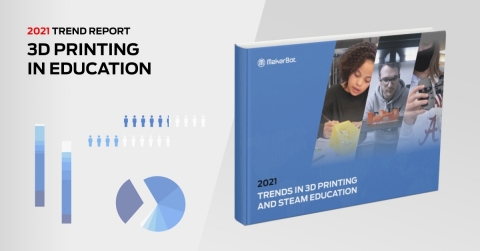Findings from MakerBot’s new trend report on 3D printing in education show its significance to continue engaging students and encouraging team collaboration in remote settings
BROOKLYN, N.Y. — (BUSINESS WIRE) — September 16, 2021 — MakerBot, a Stratasys company (Nasdaq: SSYS), today released its 2nd annual report on Trends in 3D Printing and STEAM Education, revealing how respondents leveraged 3D printing to amplify student engagement and collaboration in remote and virtual learning environments. Based on over 1,000 responses from education professionals around the world, the report also highlights some of the key factors that are leading to the increased use of 3D printing for lessons, coursework, and research projects.
This press release features multimedia. View the full release here: https://www.businesswire.com/news/home/20210916005535/en/

(Graphic: Business Wire)
Key findings from the report showed that while many schools were closed over the past year, respondents were still able to use 3D printing to support their lessons and drive student participation. Virtual learning has been a challenge for respondents, with many citing low student engagement (48%) as an obstacle. To increase involvement, respondents added extra layers of complexity to their teachings to boost creative thinking and encourage student collaboration. 57% of respondents used 3D printing for student-designed prototypes for problem-based learning projects, while 36% used 3D-printed parts related to specific lessons plans to increase student engagement. But not all remote experiences were equivalent—40% of respondents cited that their students were unable to practice their learnings due to the lack of access to equipment.
“For years, we have seen the power of 3D printing used to elevate student learning and development in the classroom. As schools look to bridge the skills gap in today’s workforce, building students’ critical thinking and creative problem-solving skills will be increasingly important,” said Nadav Goshen, CEO, MakerBot. “Over the past year, educators took 3D printing one step further, extending its capabilities to support remote education to keep students challenged, collaborative, and–most importantly–engaged.”
Additional key findings from the Trends in 3D Printing and STEAM Education report include:
- 21st century skills development continues to be an impactful factor in teaching with 3D printing. Developing creative thinking (57%) and problem-solving skills (50%) were among the top reasonings behind why respondents chose to teach with 3D printing. Using the technology to turn ideas into reality (48%) and develop critical cognitive and practical skills (45%) were also essential when integrating into class lessons.
- Teaching STEAM subjects during the pandemic was not much different than prior years. Budget constraints and insufficient funding were cited as the top reasons, at 57%, while insufficient equipment (46%) and training (38%) were additional hurdles for respondents.
- Respondents look for reliability and ease of use in their printers. In their 3D printer purchase decision-making process, 97% of respondents cited reliability as one of the most important factors, while 93% also said that the ease of use and easy maintenance were also important to consider.
- Advancements in 3D printing have propelled its use across a range of applications in higher education. Functional prototyping (65%) and concept modeling (65%) were the top applications, while R&D projects (47%) and manufacturing aids (31%) lagged behind.
- Anticipation for an exciting new school year is high. 58% of respondents cited that they were looking forward to being back in the classroom with students, while over 50% were also excited to find creative ways to teach STEAM curricula and create authentic learning experiences in the new school year. Meanwhile, 44% of respondents were looking forward to more access to the equipment in the schools.
“3D printing is a powerful and versatile learning tool that educators can use to create active learning experiences for students. With out-of-the-box, creative thinking, educators can leverage the technology to amplify their lessons to teach students in an exciting and impactful way,” added Goshen.
Download the full MakerBot report here.
About the study
MakerBot surveyed over 1,000 education professionals who are in its global network and use 3D printing in traditional or non-traditional learning settings across grade levels from kindergarten to the university level. Respondents were based in over 60 countries across North America, Asia, Europe, South America, Oceania, and Africa. They teach a range of disciplines, including 3D printing, art & design, industrial arts, mathematics, engineering, language studies, history, and more.
About MakerBot
MakerBot, a Stratasys company, is a global leader in the 3D printing industry. MakerBot empowers the engineers of today and tomorrow with its powerful additive manufacturing ecosystem. The company strives to redefine the standards for 3D printing in reliability, accessibility, precision, and ease-of-use. Through this dedication, MakerBot has one of the largest install bases in the industry and also runs Thingiverse, the largest 3D printing community in the world.
View source version on businesswire.com: https://www.businesswire.com/news/home/20210916005535/en/
Contact:
Bennie Sham
MakerBot
bennie.sham@makerbot.com